Trapping has existed for at least 6000 years, but the modern-day leghold-style traps weren’t invented until about 400 years ago (and were first designed to catch poachers, not animals). Before that, only those who learned the art and science of making traps and snares could collect games for food and other resources.
The most useful primitive traps fall into two categories: deadfall and snare. These traps are generally used to catch small to medium-sized animals.
Two other types, the pit trap and spear trap, were used on larger animals but are both dangerous and beyond the scope of traps often used for survival. Specific traps exist for birds and fish and can be productive if set up in the right area.
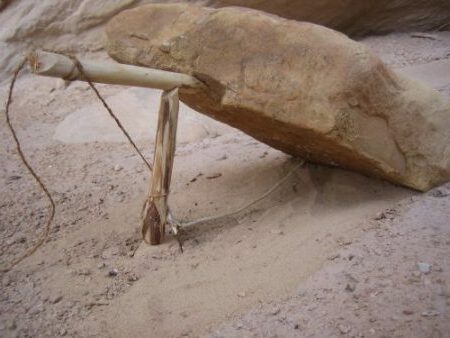
Deadfalls
Deadfalls are among the simplest and most effective traps but are often only used against the smallest animals. Generally, deadfalls use a ‘trigger stick’ somehow loaded with bait that will release a lever holding a large log or rock and dropping it on the prey. For a deadfall, it is important that the weight of the item dropped be at least five times the weight of the intended target animal.
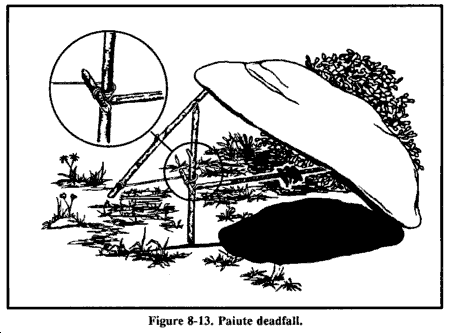
The current most popular deadfall trap seems to be the Paiute Deadfall, named for the natives of California. The only tools you will need for this trap are a small, sharp knife and a short string length.
The premise of the trap is for the trigger stick to be braced against a toggle under tension from the deadfall itself. If the trigger stick is moved too far, the toggle will release, and the weight will fall.
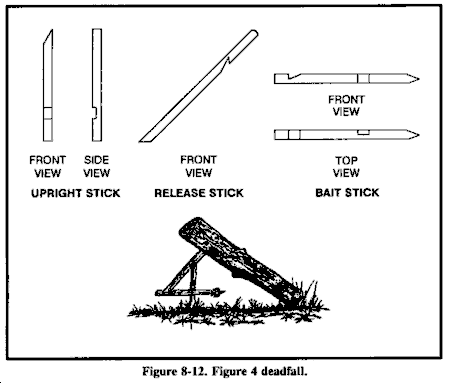
A classic deadfall for survival is the Figure-four Deadfall. The main draw of the figure-four is that it can be made with three sticks, a rock, and a decent knife. Unlike the Paiute, there is no toggle or string.
Instead, the trigger stick holds a single lever, supporting the weight. Care must be taken when notching the sticks in a figure-four as too loose, and the trap will not stay set, and too tight may cause the trap to bind up and not work.
Snares
Most people probably first saw a snare on Saturday morning cartoons where it caught some unwary animal around the leg and hoisted him off the ground. It shouldn’t be surprising that most snares don’t work like that. Snares can be set to catch animals around their extremities but are often intended to catch a medium or larger animal around the neck.
This 12-pack of snares would make a great addition to a bug-out bag or survival kit.
Unlike deadfalls, snares will require some more specialized equipment. Though you can use any string at hand, having a more durable string or, most commonly, a strong wire will be very beneficial. If using wire, a pair of pliers with cutters is a must! Some snares use bait, while others do not.
The Game Trail Snare uses a spring device. Usually, a bent sapling is fed to a trigger mechanism and then to a loop positioned on a game trail at approximately head height to the animal you anticipate will use that trail.
The animal passes its head through the loop while following the trail, which will release the trigger, and the spring will apply enough force to strangle the animal. When well placed, this is a fairly effective trap.
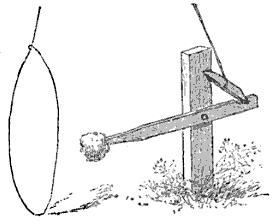
A simple baited snare is the Bait Stick Snare which works much like a deadfall. A ‘Y’ shaped branch is driven into the ground, and a toggle passed through the crotch of the ‘Y’ serves as the trigger stick. When an animal passes its head through the snare noose to get the bait stick, the toggle, under tension from the spring devise, will release, and the snare wire will strangle the animal.
Other Traps
Though trapping mammals has been more common historically, some occasions will call on targeting other animals. Making snares and traps for other animals will increase productivity and be more efficient. Often these traps are easier to set and take less wear and tear than the traps above.
A bird trap can be very productive, especially with birds known to scavenge from humans. Most bird traps resemble deadfalls but use a basket arrangement rather than a killing weight. One benefit of live trapping is that live animal do not spoil or go bad. The meat will always be available if they are cared for.
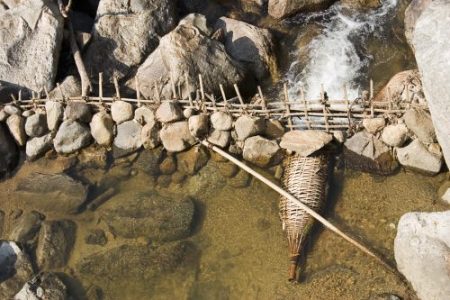
Fish traps are great because they are generally reusable with very little effort and, like bird traps, will keep your prey alive for at least a short while. Among the easiest to build, a fish trap uses a funnel arrangement to guide fish past the narrow point where it quickly widens.
Cutting the top off a 2-liter bottle, inverting it, and wedging it back inside the rest of the bottle will provide a great trap for baitfish. You can even stack rocks in a cone shape to guide fish into secluded pools if you are after larger fish.
How to Learn the art of Making Snares and Traps
While this article can be considered a jumping-off point, trapping animals has many issues. The normal learning course is studying at home and practicing in the field.
Though numerous books exist on trapping, practicing leads to many possible legal issues. Primitive trapping is not legal in most areas and where it is legal, strict seasons for trapping exist.
Developing the skill to trap can be a life-saving endeavor but do so wisely and morally. Since most of us live near communities of people, catching domestic animals is often a risk. Learn to set the traps and practice building them but if you are not in a survival situation, take the trap down before you leave.
Conclusion
Learning to make traps and snares is something many people ignore when it comes to preparedness. Building a few traps can be a lifesaver in a survival situation. Take some time to practice, and you’ll be miles ahead of the average person.

